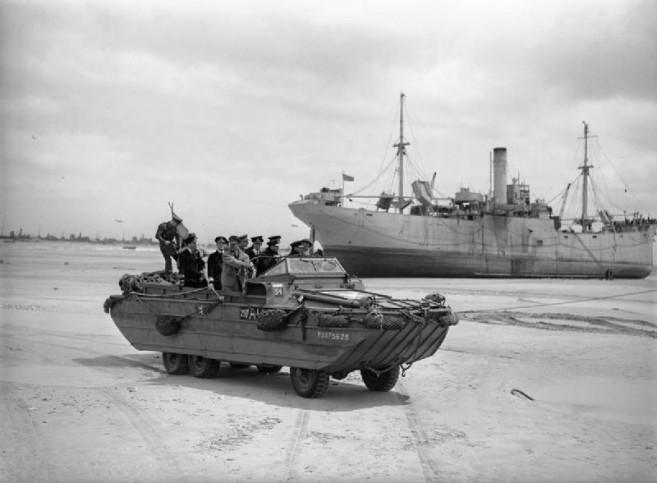Technology Model - 3 Ton Amphibian Truck (DUKW) 1942
Handcrafted model of a DUKW amphibian
The DUKW (GMC type nomenclature, colloquially known as Duck) was a six-wheel-drive amphibious modification of the 21⁄2-ton CCKW trucks used by the U.S. military during World War II. The DUKW was used to transport goods and troops over land and water, and excelled at approaching and crossing beaches in amphibious warfare attacks. The name DUKW comes from General Motors Corporation model nomenclature: D, 1942 production series; U, Utility; K, all wheel drive; and W, tandem rear axles, both driven
The DUKW was built around the GMC AFKWX, a cab-over-engine (COE) version of the GMC CCKW six-wheel-drive military truck, with the addition of a watertight hull and a propeller. It was powered by a 269.5 cu in GMC Model 270 straight-six engine. A five-speed overdrive transmission drove a transfer case for the propeller, then a two-speed transfer case to drive the axles. The propeller and front axle were selectable from their transfer case. A power take-off on the transmission drove an air-compressor and winch. It weighed 5,900 kg empty and operated at 80 km/h on road and 5.5 knots on water. It was 9.45 m long, 2.51 m wide, and 2.18 m) high with the folding-canvas top down.
The DUKW was supplied to the U.S. Army, U.S. Marine Corps and Allied forces, and 2,000 were supplied to Britain under the Lend-Lease program; 535 were acquired by Australian forces. DUKWs were initially sent to Guadalcanal in the Pacific theater, but were used by an invasion force for the first time in the European theater, during the Sicilian invasion, Operation Husky, in the Mediterranean. They were used on the D-Day beaches of Normandy and in the Battle of the Scheldt, Operation Veritable, and Operation Plunder. In the Pacific, USMC DUKWs were used to cross the coral reefs of islands such as Saipan and Guam and the tires were not affected by the coral.
Details
Details
The DUKW was the first vehicle to allow the driver to vary the tire pressure from inside the cab. The tires could be fully inflated for hard surfaces such as roads and less inflated for softer surfaces, especially beach sand. This added to its versatility as an amphibious vehicle. This feature is now standard on many military vehicles.
The models in this collection were crafted from scratch by Mr Tom Runeckles. They were periodically displayed at the Museum before their eventual donation as part of the Mobility and Firepower story.
Australian Army Museum of Western Australia
Australian Army Museum of Western Australia
Other items from Australian Army Museum of Western Australia
- Technology Model - Daimler Ferret 1952 -71 in Australian service
- Technology Model - M3 Grant MediumTank 1942
- Technology Model- Leopard 1 A3, 1988
- Technology Model - M2A2 105mm Howitzer
- Technology Model - Vickers Light Tank Mk VI 1936
- Technology Model - Mk 1 Female Tank 1916
- Technology Model - 2 Pounder Anti-Tank Gun Portee, 1941
- Technology Model - Renault Char-Mitrailleuse 1917
- Technology Model - Rolls Royce Armoured Car 1914-1941
- Technology Model - F601 Alvis Saladin Armoured Car 1958 - 1978
- Technology Model - Salvation Army Canteen Truck
- Technology Model - Alvis FV603 Saracen Wheeled Armoured Personnel Carrier

